Reading visual art: 147 Swimmers in views

If paintings of swimmers have been rare in narrative, they have been landmarks elsewhere, where some of the most significant paintings in the Impressionist canon are those painted by Claude Monet and Pierre-Auguste Renoir of a popular swimming resort near Paris.
In the summer of 1869, Renoir lived at his parents house in Louveciennes, where the Pissarros were also renting a house. He visited the Monets, who were living near Bougival, and often painted alongside Claude Monet. Some of the formative moments in Impressionism if not European art occurred when Monet and Renoir visited the popular bathing houses on the Seine known as La Grenouillère. Here Monet gave an early statement of his Impressionist agenda, a plein air oil sketch originally intended to be turned into a finished painting for submission to the Salon the following year. The pair then realised that Impressionism was about these sketched instants.
Claude Monet (1840-1926), Bathers at la Grenouillère (1869), oil on canvas, 73 x 92 cm, The National Gallery, London. WikiArt.
Monet’s Bathers at la Grenouillère (1869) is one of the most significant paintings now in London’s National Gallery, and features rows of swimmers in the river beyond the wooden pier crossing the middle of its canvas.
Pierre-Auguste Renoir (1841–1919), La Grenouillère (1869), oil on canvas, 66.5 x 81 cm, Nationalmuseum, Stockholm, Sweden. Wikimedia Commons.
Renoir painted at least three different views of La Grenouillère that summer: that above is now in Stockholm, and that below, most similar to Monet’s, is in the Oskar Reinhart Collection in Switzerland; the third (not shown) is in the Pushkin Museum in Moscow.
Pierre-Auguste Renoir (1841–1919), La Grenouillère (1869), oil on canvas, 65.1 x 92 cm, Oskar Reinhart Collection, Winterthur, Switzerland. Wikimedia Commons.
That same summer, Frédéric Bazille started painting a smaller group of young men swimming.
Frédéric Bazille (1841–1870), Summer Scene (Bathers) (1869-70), oil on canvas, 160 × 160.7 cm, Fogg Art Museum, Harvard University, Cambridge, MA. Wikimedia Commons.
Bazille began this Summer Scene, also known as Bathers, when he was on holiday in Montpellier during the summer of 1869. He had already made a series of compositional studies, from as early as February that year, but when he was working on the canvas, he didn’t find it easy going.
He eventually opted for a composition based on strong diagonals, in which the bathers in the foreground are in shade, while the two wrestlers in the distance are lit by sunshine. The landscape background was painted from the hot green mixture of grass with birch and pine trees, typical of the banks of the River Lez. He completed this painting in early 1870, and it was accepted for the Salon of that year, where it was well-received by the critics. Later that year, he was killed in the Franco-Prussian War.
On the other side of the Atlantic, swimmers also earned their place in the history of art.
Thomas Eakins (1844–1916), Swimming (The Swimming Hole) (1885), oil on canvas, 70.2 × 93 cm, Amon Carter Museum of American Art, Fort Worth, TX. Wikimedia Commons.
In 1885, Thomas Eakins painted Swimming (The Swimming Hole), appreciated today as one of the most important paintings in American art, and a masterpiece in the depiction of human form. There’s a deep irony in his choice of subject, that Eakins undoubtedly recognised. The same public who were shocked at a painting of naked people, or painting nude models in an art class, were quite used to seeing naked men swimming, even in public places. That was an accepted norm, so long as you didn’t take it into the studio or art class. This work was commissioned, and perhaps inevitably was refused, although the artist was still paid in full.
George Bellows (1882–1925), Forty-two Kids (1907), oil on canvas, 106.7 × 153 cm, The National Gallery of Art, Washington, DC. Wikimedia Commons.
George Bellows’ Forty-two Kids from 1907 shows unruly youths at play by the water, in apparent homage to Eakins’ Swimming, restaged in this urban setting.
Henri-Edmond Cross (1856–1910), Bathers or Happy Bathing (1899-1902), oil on canvas, dimensions not known, Private collection. Image by Ibex73, via Wikimedia Commons.
Several of the French artists who had moved to the Midi (the south of France) were experimenting with the use of photography, and this appears to have influenced Henri-Edmond Cross in his Bathers or Happy Bathing, which he started painting in 1899 and completed in 1902. Despite his chroma nearing Fauvist levels, Cross has retained his subtlety in the gradation and transition of colour.
Lovis Corinth (1858–1925), Swimming in Horst – Ostsee (1902), oil on canvas, dimensions not known, Museum Georg Schäfer, Schweinfurt, Bavaria. Wikimedia Commons.
Also in 1902, Lovis Corinth visited the south coast of the Baltic, where he painted Swimming in Horst – Ostsee, now the Polish resort of Niechorze.
Joaquín Sorolla y Bastida (1863–1923), The White Boat, Jávea (1905), oil on canvas, 105 x 150 cm, Private collection. WikiArt.
Back in warmer waters, Joaquín Sorolla’s The White Boat, Jávea, was painted during his summer campaign on the coast to the south of Valencia in 1905.
Maurice Denis (1870–1943), Wave (1916), oil on canvas, 100 x 124 cm, Ohara Museum of Art 大原美術館, Kurashiki, Japan. Wikimedia Commons.
Among the few paintings of Maurice Denis featuring nudes is Wave from 1916, with their forced classical poses.
Finally, one of Aksel Waldemar Johannessen’s earliest surviving paintings is a startling view of two swimmers.
Aksel Waldemar Johannessen (1880–1922), Man on a Diving Board (1912), oil on canvas, 180 × 89 cm, Private collection. Wikimedia Commons.
Man on a Diving Board from 1912 shows a well-muscled man in bathing trunks bending forward as he sits on the end of a diving board. Below him, just under the surface of the water, is a young woman wearing a bright red costume, including a hat.




